science-aficionado-blog
I am a science enthusiast,the universe constantly amazes me, from the functions of microscopic biology to the granduer of cosmology,from recent technological innovations to geology,chemistry and so forth. I want a blog that has: accurate source checked facts,interesting findings with links to the studies,and peer reviewed papers. I will cover anything scientific, either theoretical or applied,from any branch. I also want this blog to be appealing to a layman, while at the same time still interesting to someone with more experience. So please, follow me and message me with any suggestions.
18 posts
Latest Posts by science-aficionado-blog




Only 57.5% of eligible voters actually voted in the last election. And only 42% of eligible 18–34 year-olds.
Register to vote!

People with Crohn’s disease know the uncomfortable symptoms of the chronic condition all too well: diarrhea, abdominal pain, weight loss and fatigue, among others. But what doctors have not been able to tell the approximately 565,000 people in the U.S. with Crohn’s is why they’ve developed the inflammatory bowel condition in the first place.
Most experts suspect the condition is the result of the body’s immune system attacking healthy cells, mistakenly triggered by bacteria in the digestive tract. Now, a new study has identified a specific fungus and two bacteria they think play a key role in what leads some people to develop the disease.
“Among hundreds of bacterial and fungal species inhabiting the intestines, it is telling that the three we identified were so highly correlated in Crohn’s patients,” the study’s senior author Mahmoud A. Ghannoum, professor and director of the Center for Medical Mycology at Case Western Reserve and University Hospitals Cleveland Medical Center, said in a press release.
Research has previously identified that E. coli bacteria contribute to Crohn’s symptoms, but this is the first study to show the bacteria Serratia marcescens and the fungus Candida tropicalis are also involved.
Continue Reading.

Richard Dawkins weighs in on the political debate. / via
Why Sequencing DNA in Space is a Big Deal
… And How You Can Talk to the Scientists Who Made It Happen

Less than one month ago, DNA had never been sequenced in space. As of today, more than one billion base pairs of DNA have been sequenced aboard the International Space Station, Earth’s only orbiting laboratory. The ability to sequence the DNA of living organisms in space opens a whole new world of scientific and medical possibilities. Scientists consider it a game changer.

NASA astronaut Kate Rubins, who has a background in genomics, conducted the sequencing on the space station as part of the Biomolecule Sequencer investigation. A small, commercial, off-the-shelf device called MinION (min-EYE-ON), manufactured by Oxford Nanopore Technologies in the UK, was used to sequence the DNA of bacteria, a virus and rodents. Human DNA was not sequenced, and there are no immediate plans to sequence human DNA in space.

(Image Credit: Oxford Nanopore Technologies)
The MinION is about the size of a candy bar, and plugs into a laptop or tablet via USB connection, which also provides power to the device. The tiny, plug and play sequencer is diminutive compared to the large microwave-sized sequencers used on Earth, and uses much less power. Unlike other terrestrial instruments whose sequencing run times can take days, this device’s data is available in near real time; analysis can begin within 10-15 minutes from the application of the sample.

Having real-time analysis capabilities aboard the space station could allow crews to identify microbes, diagnose infectious disease and collect genomic and genetic data concerning crew health, without having to wait long periods of time to return samples to Earth and await ground-based analysis.
The first DNA sequencing was conducted on Aug. 26, and on Sept. 14, Rubins and the team of scientists back at NASA’s Johnson Space Center in Houston hit the one-billionth-base-pairs-of-DNA-sequenced mark.

Have more questions about how the Biomolecule Sequencer works, or how it could benefit Earth or further space exploration? Ask the team of scientists behind the investigation, who will be available for questions during a Reddit Ask Me Anything on /r/science on Wednesday, Sept. 29 at 2 p.m. EDT.
The participants are:
Dr. Aaron Burton, NASA Johnson Space Center, Planetary Scientist and Principal Investigator
Dr. Sarah Castro-Wallace, NASA Johnson Space Center, Microbiologist and Project Manager
Dr. David J. Smith, NASA Ames Research Center, Microbiologist
Dr. Mark Lupisella, NASA Goddard Space Flight Center, Systems Engineer
Dr. Jason P. Dworkin, NASA Goddard Space Flight Center, Astrobiologist
Dr. Christopher E. Mason, Weill Cornell Medicine Dept. of Physiology and Biophysics, Associate Professor

About 42,000 years ago, the Neanderthals — the stocky cousins of modern humans — fashioned tiny jewelry beads from animal teeth, shells and ivory, a new study finds.
The finding is momentous, as it suggests that Neanderthals could engage in symbolic expression — the ability to make art — before they went extinct about 30,000 years ago, the researchers said.
“We now know that some of the last Neanderthals in Europe made artifacts that we do not see in Neanderthal material culture before that time,” said Frido Welker, the study’s lead researcher and a doctoral student of human evolution at the Max Planck Institute for Evolutionary Anthropology in Germany.
Continue Reading.
![This Is How Elon Musk Plans to Build a City on Mars [Updating]](https://64.media.tumblr.com/8b5208e52794d1bc93e7598f6e687358/tumblr_oe6k4aUjTU1tr9vtu_og_540.png)
SpaceX plans to build a “self-sustaining city” on Mars, company founder Elon Musk announced today. Here’s what we know about how they plan to do it.
Musk dropped the news during an address at the International Astronautical Congress meeting in Guadalajara, Mexico, where he had promised to reveal how the company planned to send people to Mars—and how it would keep them alive once they got there. Today, we finally got the first news of how he intended to do that.
“I don’t have an immediate doomsday prophecy,” said Musk, but noted that he saw only two possible paths forward. “One path is to stay on Earth forever and there will be some extinction event. The alternative is to become a multi-planetary species, which I hope you will agree is the right way to go.”
Continue Reading.

SOMEI
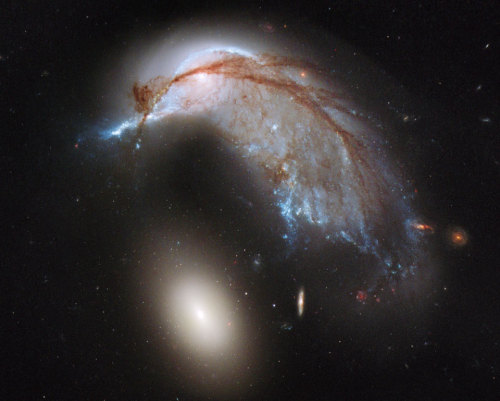
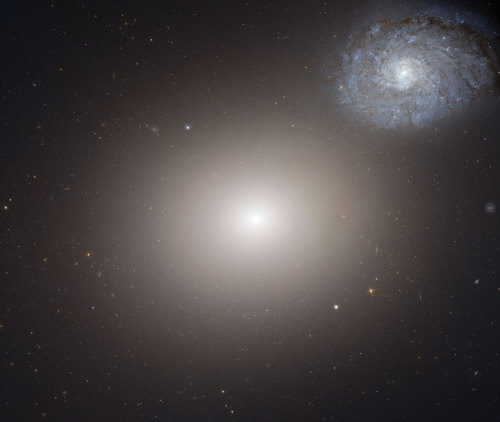
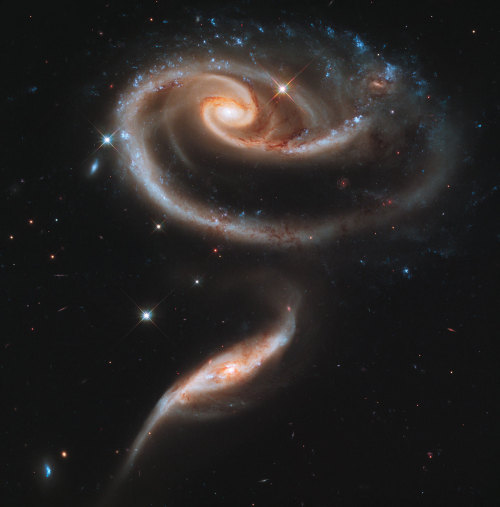
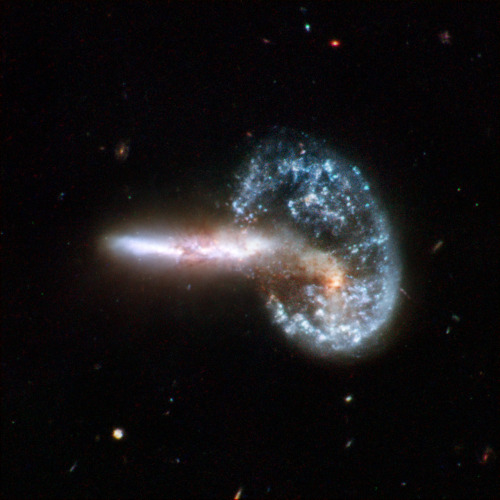

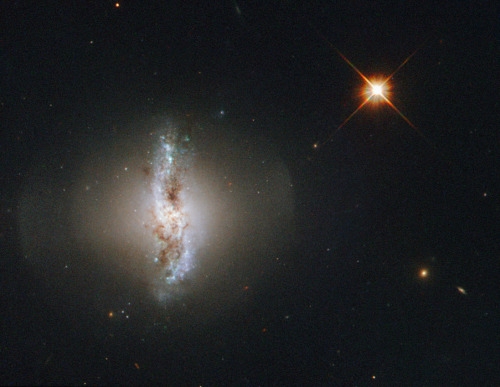
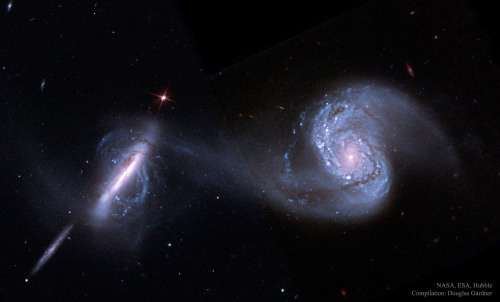



Top 10 Bizarre Galaxy Pairs From Hubble
“The Arp catalog illustrates galaxies in many different stages of a collision:
* prior to their first close pass, * in the collision process, * subsequent to an interaction but before merging, * and in the final merger stages.
Unlike ellipticals, spirals are easily disturbed, often becoming destroyed entirely by such an interaction.”
When you take a glimpse into the deep Universe, beyond the gas, dust, stars and planets of our own galaxy, you enter the realm of the galaxies. In general, they come in two types: the spirals, with neat, orderly arms, and the ellipticals, with a symmetric, bulging shape. But for everything that exists in the Universe a particular way in general, there are exceptions. In the 1960s, astronomer Halton Arp became fascinated with these exceptions, creating a catalog of 338 examples: the Atlas of Peculiar Galaxies. We now know that most of these are galaxy pairs or triplets in the process of major mergers, displaying features such as tidal disruption, stellar bridges, starbursts and occasionally a rare, ring shape.
XD

xkcd: Christmas Plans
(Anti)Christmassy physics…
NASA has discovered more evidence that water erupts from beneath the surface of Europa, one of the many moons of Jupiter. The new findings lend more legitimacy to observations from 2013, and further tease the possibility that Europa contains a subsurface ocean. A team from the Space Telescope Science Institute (STScI) made the observations using the Hubble Space Telescope, and the agency announced the findings during a teleconference this afternoon. The full findings will be published in the Astrophysical Journal on September 29th.
The STScI team watched Europa travel across the face of Jupiter on 10 different occasions over a period of 15 months, starting in December of 2013. During three of those transits, the team captured what appeared to be plumes of water vapor erupting from near the icy moon’s south pole. William Sparks, a STScI astronomer who led the research team, called the findings “statistically significant” — even if they aren’t proof. “We do not claim to have proven the existence of plumes, but rather to have contributed evidence that such activity may be present,” Sparks said.
It’s not proof, but it’s a great sign
NASA has found evidence of water all over our Solar System, but the agency has only directly spotted geysers on one body — Enceladus, a moon of Saturn. Scientists have long proposed that Europa is home to a subsurface ocean, but it took until 2012 to find evidence of water plumes erupting from that ocean. That year, a different NASA research team spotted aurorae in the southern region of Europa. Aurorae are caused by charged particles interacting with an atmosphere — we see them on Earth (you may know them as the Northern and Southern lights) thanks to the Sun’s solar wind. The light show on Europa has a different cause — hydrogen and oxygen, scientists argued. But the indirect connection wasn’t enough to confirm the existence of water plumes.
The three separate observations made by Sparks’ team.
Sparks’ team spotted the evidence in a more direct way. The team was using Hubble to measure Europa’s atmosphere as the moon transited across the bright background of Jupiter. This technique is similar to what planetary scientists use when they try to determine the atmospheric qualities of exoplanets. The light coming from the bigger, brighter object in the background makes it easier to see features at the edges of smaller, more dimly lit objects in the foreground.
What Sparks’ team saw was one step closer to direct images of water plumes. Dark splotches appeared in the same southern region of Europa every few months. This is a hint that Europa’s surface breaks up now and then due to the massive gravity of Jupiter. When the surface cracks, the rifts sometimes run deep enough to release water into the atmosphere from the ocean below. The team estimates that these plumes shoot out about 125 miles (200 kilometers) above Europa before they fall back down to the surface, similar to estimates from the 2012 observations.
On the left is an image taken by Sparks’ team that shows what appears to be water plumes. On the right is a measurement of aurorae from the 2012 findings.
NASA believes Europa’s ocean could have Earth-like qualities that we know to be beneficial to life. But Europa’s surface is thought to be miles thick, which would make it hard to directly measure that ocean. The possibility of plumes on Europa is tantalizing because it offers a new (and easier) way to make those measurements.
NASA already plans to send a spacecraft — known as the Europa Clipper — to the icy moon in the 2020s. The agency has said it won’t send the Clipper through these plumes like the Cassini spacecraft did when it studied Enceladus. But a proposed lander, or even a second orbiter (which would fly closer to Europa than the Clipper), could tag along and directly measure these plumes for evidence of life.
The Clipper mission is a long way out, though. More observations can be done from Earth before then, and Sparks’ team has already started on these. But he was also careful to note that, like the team in 2012, they’re already stretching the limits of the 26-year-old Hubble. More detailed observations — and actual proof of water plumes — might have to wait until Hubble’s successor, the James Webb Space Telescope, launches in 2018.
via http://ift.tt/oZfQdV

Ask A Biologist - Dr. Biology - School of Life Sciences, Arizona State University | Biology …
astronomer Maria Mitchell, who paved the way for women in American science, admonished the first class of female astronomers at Vassar in 1876. via Pocket
Amazing source for an amateur rocket scientist.
For any Apollo enthusiasts.
At least now we know why. But was it really worth it?





Jupiter’s Galilean Moons
Io - Jupiter’s volcanic moon
Europa - Jupiter’s icy moon
Ganymede - Jupiter’s (and the solar system’s) largest moon
Callisto - Jupiter’s heavily cratered moon
Made using: Celestia, Screen2Gif & GIMP Based on: @spaceplasma‘s solar system gifs Profile sources: http://solarsystem.nasa.gov/planets, http://nssdc.gsfc.nasa.gov/planetary/factsheet/joviansatfact.html
